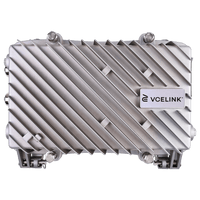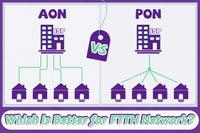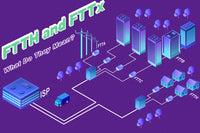Contents
FTTH and GPON technologies have been used for years and they are indispensable in modern networks. GPON ONU is a network endpoint device playing an important role in fiber-to-the-home (FTTH) networks in the last mile. This blog delves into everything about GPON and GPON ONU like their working principles and functions!
What is GPON?
As is known to all, a passive optical network refers to a network system that carries optical signals from internet service provider (ISP) to end users via fiber optic cables. GPON, short for Gigabit Passive Optical Network, is a type of point-to-multipoint network system used in fiber-to-the-home (FTTH) or fiber-to-the-premise (FTTP). GPON uses Asynchronous Transfer Mode (ATM) protocol so that it can encode audio, video, and data traffic, ensuring high-speed communication. It also provides multi-service integration for VoIP, data, and (Internet Protocol television) IPTV services with a large bandwidth over a long distance.
A GPON system typically includes a GPON ONU (ONT) and GPON OLT using a passive optical distribution network. GPON starts from an optical line terminal (OLT) located at the ISP and the data is delivered to the passive optical splitter and then the light is separated into multiple signals with ONU (ONT) devices. The maximum downstream speed of GPON can reach 2.5 Gbps and the maximum upstream speed is 1.25 Gbit/s.
GPON vs. EPON
GPON (Gigabit Passive Optical Network) and EPON (Ethernet Passive Optical Network), belonging to PON networks, were developed by ITU-T and IEEE respectively to provide Gigabit fiber optic solutions. GPON and EPON differ in many features and services.
Firstly, they support different data rate modes. Generally, EPON offers a fixed downlink and uplink speed of 1.25Gbps. In contrast, GPON can support symmetrical data speeds of 622 Mbps or 1.25 Gbps and asymmetrical data rates with a downlink speed up to 2.5 Gbps and uplink speed up to 1.25 Gbps. In terms of bandwidth and data rate, GPON outperforms EPON.
Splitting ratio refers to the number of users that can be served by a PON system. The larger the splitting ratio, the shorter the transmission distance. GPON and EPON share similarities concerning split ratios. Both GPON and GPON can provide split ratios of 1:32, 1:64, 1:128.
Another difference between GPON and EPON lies in their quality of service (QoS) handling. GPON has integrated QoS functions such as Ethernet, Time Division Multiplex(TDM), and Asynchronous Transfer Mode (ATM). In contrast, EPON lacks built-in QoS; users requiring a viable PON system need to use VLAN tags at a higher cost.
GPON has more powerful OAM capabilities than EPON. According to ITU-T G.984.X standard, it supports multiple management channels such as OAM (Operation Administration and Maintenance), PLOAM (Physical Layer OAM), and OMCI (ONT Management and Control Interface). However, EPON supports IEEE 802.3ah OAM messages for simple loopback and link monitoring. While GPON outperforms EPON, EPON performs better in the ease of deployment and cost-effectiveness.
What is ONU?
ONU (Optical Network Unit) is terminal equipment used in the GEPON system transmitting electrical signals to optical signals or vice versa. There is often confusion between an ONU and an ONT (Optical Network Terminal). In fact, they are almost the same thing. ONT is an ITU-T term, while ONU is an IEEE term.
ONUs can provide data, video, IPTV, and voice for “triple-play” applications. They also feature powerful OAM capabilities used for remote management. Additionally, they use authentication, encryption, and advanced QoS to enhance secure and efficient communication. The ONU plays an important role in modern networks, enabling centralized control and efficient data transmission.
How Does A GPON ONU Work?
So, how does a GPON ONU or GPON ONT work? A GPON system consists of OLT, ODN, and ONT/ONUs.
In the GPON network, the ONU is located at the user’s premises. The ONU has two working modes. In downstream traffic, it receives optical signals from the OLT located in the ISP’s center office via the fiber optic cable. Then the ONU’s transceiver transforms these optical signals into electrical signals and finally, they are delivered to end-user devices, such as desktops, phones, routers, etc. In upstream traffic, end-user devices send electrical signals carrying data, voice, video, or internet requests to the ONU. Then, the ONU converts these signals back into optical signals and delivers them back to the OLT through fiber optic cables. An ODN is essential if the physical distance between OLT and ONU is farther than 20 km.

How to Choose the Correct GPON ONU?
Choosing the correct GPON ONU or GPON ONT is essential for boosting your FTTH network performance. Here are a few factors that you can consider.
- Compatibility
Ensure the ONU is compatible with your ISP’s GPON OLT. Check the compatibility with the specific GPON standards and protocols used by OLTs. While some ISPs may provide ONUs, if you want to use an ONU from different manufacturers, you’d better look for one that is interoperable with various OLT brands.
- Speed Requirement
Choose an ONU with necessary downstream and upstream data rates. The entry-level ONU typically supports download speeds of up to 1 Gbps. However, if you require a higher network speed for activities such as transmitting large-scale data or streaming HD videos, an entry-level ONU is not enough to handle these demands and you need to purchase a more advanced ONU.
- Wi-Fi Capability
You also need to consider whether you require an ONU device with built-in Wi-Fi capability. Many GPON ONUs come with integrated Wi-Fi functions, which cannot only convert optical signals to electrical signals but also contain built-in Wi-Fi access points. This allows you to connect to a wireless network easily within the home or office without the need for an additional Wi-Fi router.
- Physical Consideration
Check the number and types of ports based on your specific needs. A basic ONU normally features a PON port and several Ethernet ports. But if you need voice support and coaxial cable connectivity, you may need to choose an ONU with VoIP and CATV ports.
ONUs usually come in different styles, including panel-type, rack-mounted, and wall-mounted types. Opting for the right ONU depends on your installation environment. For example, standard and wall-mounted ONUs are suitable for home or small offices. If your ONU will be installed in an outdoor environment, make sure that it can withstand wind, dust, and water.
Introducing Our GPON ONU
GPON ONU is a key component in the last mile of FTTH networks. We’re proud to introduce our GPON ONU. This GPON ONU is designed for home and office, providing high-speed and reliable network connectivity. Explore our GPON ONU in the following content.
Why Choose Our GPON ONU?
- Superior Performance
This GPON ONU supports GPON downstream speed of 2.5 Gbps and upstream speed of 1.25 Gbps and EPON downstream and upstream speed of 1.25 Gbps for both basic and high-demand applications like HD video streaming and large data transmission. It also features powerful QoS features to prioritize different types of service traffic. Additionally, our GPON ONU integrates Wi-Fi 6 functionality and you don’t need to buy an additional router.
- Service Support
Our GPON ONU supports triple-play services, such as data, video (CATV), and voice (VoIP) services. It features several ports besides PON and Ethernet ports, including a CATV RF port, USB port, and VoIP port to meet your specific requirements.
- Powerful Compatibility
Our ONU is interoperable with the most well-known OLT brands in the world, including Nokia, Huawei, ZTE, Fiberhome, Calix, and Dasam, ensuring seamless integration with your existing network infrastructure. It is compliant with GPON ITU-T G984.X and EPON IIEEE 802.3ah standards, guaranteeing reliable and stable performance.
- Easy Installation and Management
The ONU is easy to operate and manage. It supports an user-friendly Graphical User Interface (GUI) with a plug-and-play design, suitable for quick deployment of multiple services. It also supports auto-firmware upgrades. Remote service distribution, fault diagnosis, and performance statistics can be realized by OMCI, which effectively reduces operation and maintenance costs. It can also support remote switching RF signals for subscriber management.
- Reliability and Security
It complies with the carrier-level requirements, ensuring high reliability in hardware, software, and other systems. With the Dying Gasp functionality, the ONU can report an alarm to the optical line terminal when a power outage occurs, ensuring that the problem is resolved promptly.

It also incorporates with security features to protect the network, like encryption, authentication, built-in firewall capacity, and secure access control. With these advanced security measures, this GPON ONU can provide comprehensive protection against unauthorized access and data breaches.
Our GPON ONU device is designed for home network demands and SOHO (small office and home office) networks. It is suitable for home broadband, e-government, and enterprise access with integrated access demands of broadband, data, video, etc. This ONU provides various services, such as high-speed Internet access, online video on demand, video conference, and large file transfer services to users.
For more information on this topic, you can keep up on our blogs. While VCELINK offers general and basic information for our customers and other visitors to the website, it’s not professional advice.





Be the first one to comment.
Leave a comment